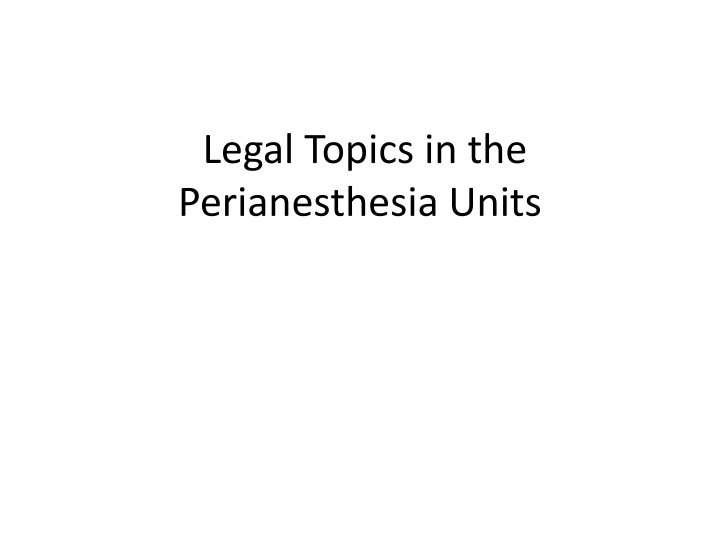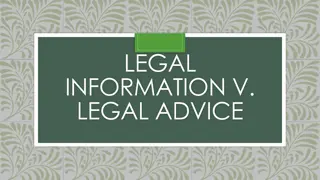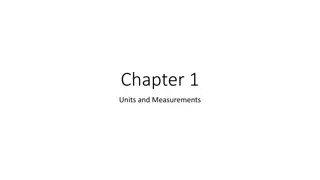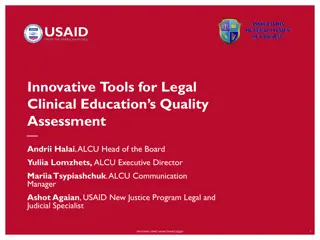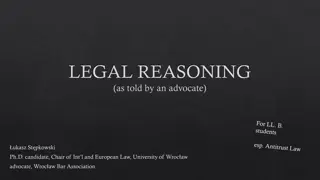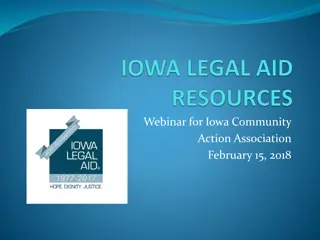Legal Topics in the Perianesthesia Units
Explore professional issues, elements essential for proving malpractice, high-risk cases, nursing standard of care, and standards of nursing care in perianesthesia units. Learn about the authoritative statements that describe competent nursing practice and the establishment of standards of care by entities like ASPAN, The Joint Commission, and the American Nurses Association.
Download Presentation

Please find below an Image/Link to download the presentation.
The content on the website is provided AS IS for your information and personal use only. It may not be sold, licensed, or shared on other websites without obtaining consent from the author.If you encounter any issues during the download, it is possible that the publisher has removed the file from their server.
You are allowed to download the files provided on this website for personal or commercial use, subject to the condition that they are used lawfully. All files are the property of their respective owners.
The content on the website is provided AS IS for your information and personal use only. It may not be sold, licensed, or shared on other websites without obtaining consent from the author.
E N D
Presentation Transcript
Legal Topics in the Perianesthesia Units
Objectives Relate professional issues to perianesthesia practice. Identify 4 elements essential for proving malpractice. Describe perianesthesia high risk cases.
What does the nursing standard of care mean?
Nursing Standard of Care Describes kind of care the patient can expect and receive from the nurse. Authoritative statements that describe competent level of clinical nursing practice demonstrated through the nursing process.
Standards of Nursing Care Are any established measure of extent, quality, quantity Value an agreed upon level of performance a degree of excellence of care that is established
Standards of Care Describes a competent level of care: assessment diagnosis interventions evaluation
Standard of Care Professional Performance Describe what nurses do for or with patients and patient families Authoritative statements describing competent level of behavior Include quality assurance (performance improvement), ethics, education, consultation, research, peer review, accountability Nursing Care Describes kind of care patient can expect and receive from the nurse Authoritative statements that describe competent level of clinical nursing practice demonstrated through the nursing process assessment, diagnosis, interventions, and evaluation
Who May Establish Standards of Care? ASPAN The Joint Commission The American Nurses Association (ANA) Institutional rules or hospital standards developed by institutions for their staff and patients
Who May Establish Standards of Care? Unit practice standards, policies, protocols are specific standards of care for specific groups of types of patients Precedent court cases define what a reasonable, prudent nurse would have done in a similar situation Specialty nursing organization standards standards developed nursing specialty organizations (ASPAN, AACN, AORN, ENA)
Who May Establish Standards of Care? Certification in a specialty area as a means by which a professional organization attests that an individual has attained proficiency in an area of that profession s practice
What are the current ASPAN Standards? 2017-2018 2019-2020 Standards available in December 2018 for implementation in January 2019
STANDARDS 2017-2018 Perianesthesia Nursing Standards, Practice Recommendations and Interpretive Statements This text contains standards of perianesthesia nursing practice evidence-based clinical practice guidelines practice recommendations position statements resources from partnering organizations interpretive statements
ASPAN Standards Include Standards: generic statements which best describe the desirable and achievable level of performance Guidelines: developed from systematic review of literature and research, a prime tool for evidence based practices, and require frequent updating as new information becomes available Practice Recommendations: which best describe the desirable and achievable level of performance expected of perianesthesia registered nurses.
ASPAN Standards Include Position Statements: represent an organization s viewpoint on a particular issue Resources: recommendations for practice based primarily on expert consensus, expertise and opinion from partnering organizations INTERPRETIVE STATEMENTS provided in sidebar format offer clarification, definitions and examples
2017-2018 Standards Effective January 1, 2017 Revised and expanded Includes: Scope of Perianesthesia Nursing Practice Principles of Perianesthesia Practice Ethical Practice Safety 6 Standards 11 Practice Recommendations 15 Position Statements 5 Resources including Clinical Practice Guidelines (posted on web site http://www.aspan.org)
Scope of Perianesthesia Nursing Practice Preanesthesia level of care Preadmission Day of surgery/procedure Postanesthesia levels of care Phase I Phase II Extended Care Settings
Perianesthesia Standards for Ethical Practice Competency Responsibility to patients, Professional responsibility, Collegiality, Research, Advocacy
Principles of Safe Perianesthesia Practice ASPAN s core values for a culture of safety include Communication Advocacy Competency Efficiency/Timeliness Teamwork
Standards of Perianesthesia Nursing Practice
I. Patient Rights Perianesthesia nursing practice is based on philosophical and ethical concepts that recognize and maintain autonomy, confidentiality, dignity and worth of individuals Criteria Written policies exist for identifying and resolving ethical dilemmas Nursing practice reflects an understanding of ethical, moral and legal issues HIPAA protects the patient s rights of confidentiality
Standard I: Patient Rights Case Nurse loses position for breach of confidentiality through computer entry into patient files including diagnostics and other privileged information. Hospital/facility has policy regarding patient confidentiality
Standard II: Environment of Care Standard: Perianesthesia nursing practice promotes and maintains a safe, comfortable and therapeutic environment. Outcome: patient, staff & visitor will be free from adverse effects associated with environmental and safety factors Criteria: Phase I level of care is in close proximity where anesthesia is administered
Criteria: Preanesthesia, Phase I, Phase II and Extended care are distinct levels of care Perianesthesia areas adhere to institution- specific practices regarding access, security and safety. Preanesthesia patients are separated from patients undergoing procedures and/or recovering from anesthesia/sedation
Standard II Environment of Care Case QI shows increased patient nausea and vomiting when preoperative and postoperative patients are mixed in same room. Mother transports infant home without second person in auto. Child has obstructed airway Patient with latex allergy is exposed to use of non- powdered latex gloves while in PACU
Standard III: Staffing and Personnel Management Standard: Appropriate number or RNs with demonstrated competence available in each level of care based on Patient acuity Census Patient flow process Physical facility
III. Staffing and Personnel Management Criteria Staffing patterns Staff function within job performance descriptions Orientation plan Performance appraisals Staffing based on patient acuity, census, and physical facility Written staffing policy
III. Staffing and Personnel Management Criteria The perianesthesia nurse providing Phase I level of care will maintain current Advanced Cardiac Life Support (ACLS) and/or Pediatric Advanced Life Support (PALS) provider status, as appropriate to the population served. It is strongly recommended the perianesthesia nurse providing Preop/Day of Surgery and Phase II level of care maintain a current ACLS and PALS or Pediatric Emergency Assessment Recognition and Stabilization (PEARS) provider status if appropriate
III. Staffing and Personnel Management Staffing in preadmission units is dependent on patient volume, patient health status, and required support for preanesthesia interventions Two registered nurses, one of whom is competent in Phase I postanesthesia nursing are in the same room/unit where the patient is receiving Phase I level of care .
III. Staffing and Personnel Management Two competent personnel, one of whom is an RN competent in Phase II postanesthesia nursing, are in the same room/unit where the patient is receiving Phase II level of care. Two competent personnel, one of whom is an RN possessing competence appropriate to the patient population are in the same room/unit where the patient is receiving Extended care level of care. The need for additional RNs and support staff is dependent on patient acuity, patient census and the physical facility.
Standard III Staffing & Personnel Management Case Child has orthopedic surgery. Arrives in PACU where only one nurse is available to care for patient. 2ndnurse is changing clothes in the dressing room. Anesthesiologist leaves patient with PACU nurse to set up for next case. Patient is non-responsive and ultimately has respiratory arrest after anesthesiologist leaves the PACU.
Standard IV: Quality Improvement Standard RN monitors and evaluates care Areas for improvement are resolved through a collaborative multidisciplinary approach. The perianesthesia quality improvement program is integrated into the organizational program.
Standard IV QI Case Monitored pain levels in patients in ambulatory setting. Same anesthesiologist for patients with increased pain. Had no narcotics in the O.R. It was his practice in anesthesia delivery. Department of Anesthesia reviewed cases and looked at pain management within the department.
Standard V: Research and Clinical Inquiry Standard: Nurses participate in clinical inquiry. Includes: Research & research-related activities Evidence-based practice QI activities Small tests of change that test innovation
Standard V Research & Clinical Inquiry Case When ASPAN did one of the initial Delphi studies, it was discovered that the Aldrete scoring system had not been validated. Since that time the scoring system has been changed.
Standard VI: Nursing Process Standard: Applied to each patient Assessment & data collection provide basis for individualized plan of care Plan of care is based on initial and ongoing assessments and guides nurse to intervene to meet needs and goals. Multidisciplinary treatment plan & implementation of collaborative therapeutic interventions. Evaluation of patient s health status determines the effectiveness of the plan of care
Standard VI Case Pre-surgical Assessment: Nurse s error linked to postop infection. Patient has a lengthy history of surgeries to remove tumorous lumps from her breasts A postop infection occurred after one of the surgeries. Patient was questioned prior to surgery whether a CBC had been done. nurse erroneously checked off a recent CBC (within 14 days) had been done. It had been several months. Surgery was conducted and patient developed an infection ultimately resulting in full bilateral radical mastectomies. DeStasio vs. Kocsis, 2007
Standard VI Nursing Process Case Patient develops compartment syndrome after orthopedic procedure on leg. Upon review of charting, there is no evidence of any capillary refill or pulse checks of lower extremities. Assessment data not documented - so juries concur: if not documented, not done.
Standard VI Cases 28 year old healthy female admitted to Phase I PACU status post BMT Placed on monitor including oxygen saturation. Alarms were turned OFF. Nurse assumed patient was just a little sleepy and left the bedside for significant amount of time. A call bell/light was not left within the patient s reach. The oxygen saturation decreased probably from an undetected seizure.
Standard VI Case continued By the time the nurse checked on the patient and help was called for, the patient was brain dead. NO Ongoing monitoring Departure from unit violated guideline for monitoring patients Alarms OFF not acceptable.
To Purchase Standards ASPAN 90 Frontage Road Cherry Hill, NJ 08034-1424 Toll free 877.737.9696 Fax 856.616.9601 Email aspan@aspan.org www.aspan.org
LAW Public: constitutional, administrative and criminal law; private or civil; relationship with one another Rule or standard of human conduct Established and enforced by authority, society or custom Tells us what we can and cannot do Statutory: Passed by federal or state legislature
Tort Law Concerns wrongful act, damage or injury done Civil suit can be brought Malpractice falls in this category
LEGAL ISSUE DEFINITIONS TORT - CIVIL WRONGDOING INTENTIONAL Assault: Threat to do bodily harm Battery: Committing bodily harm Invasion of Privacy False Imprisonment Defamation Inflicting Emotional Stress
LEGAL ISSUE DEFINITIONS TORT - CIVIL WRONGDOING NONINTENTIONAL PROFESSIONAL NEGLIGENCE- Failure to do what reasonably prudent person under similar circumstances would do. MALPRACTICE - Improper or negligent treatment resulting in damages/injury.
LEGAL ISSUE DEFINITIONS Beneficence: Doing good for the patient Nonmaleficence: Do No harm to patient Autonomy: Freedom of action as chosen by an individual Justice: Duty to be fair to all people Res ipsa loquitur: the thing speaks for itself Expressed consent: Agree by direct words, written or oral Implied Consent: Inferred by conduct or in emergency situations
LEGAL ISSUE DEFINITIONS Durable Power of attorney for Health Care: advance directive allows competent patients to appoint an individual the right to make decisions for them if they become unable to do so Living Will: document written for the future while the person is able to still make decisions for the time when he/she is unable to do so.
LIABILITY 4 elements of negligence for liability suit DUTY: Need to be professional relationship between health care provider and health care consumer. BREACH of DUTY: Damages must be due to negligence DAMAGE: There must be an injury (damages- physical, mental, financial) CAUSES: Damages must be direct and proximate result of negligence
Duty Once you accept care of a patient, you have a duty to act in accordance with the Standard of Care. You take report, you have accepted that duty.
Breach of Duty Acts of commission or omission Breach of Standard of Care: conduct that falls below the standard of care established by law for patient s protection against reasonable risk of harm Care does not change due: to credentials of nurse institution age or category of patients
Damage - Actual loss or damages must be established -If no physical, mental, or financial injury exists then there is no liability despite the negligent act.
